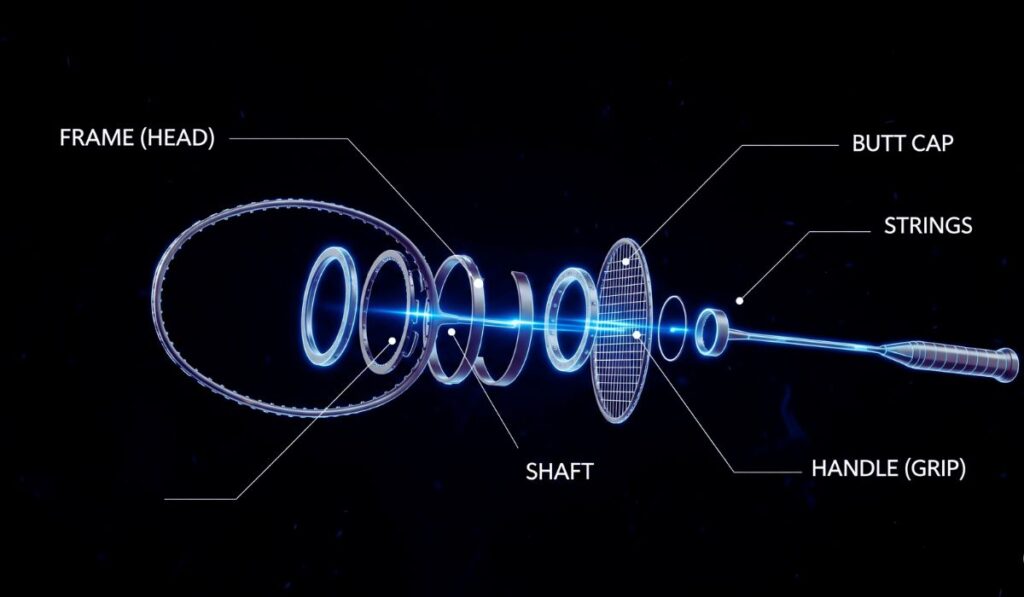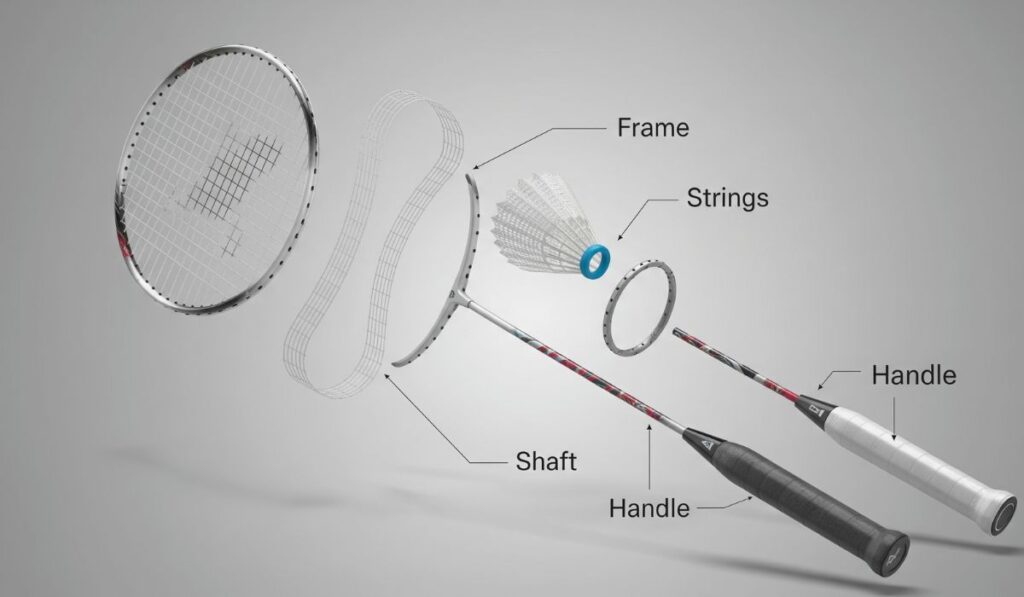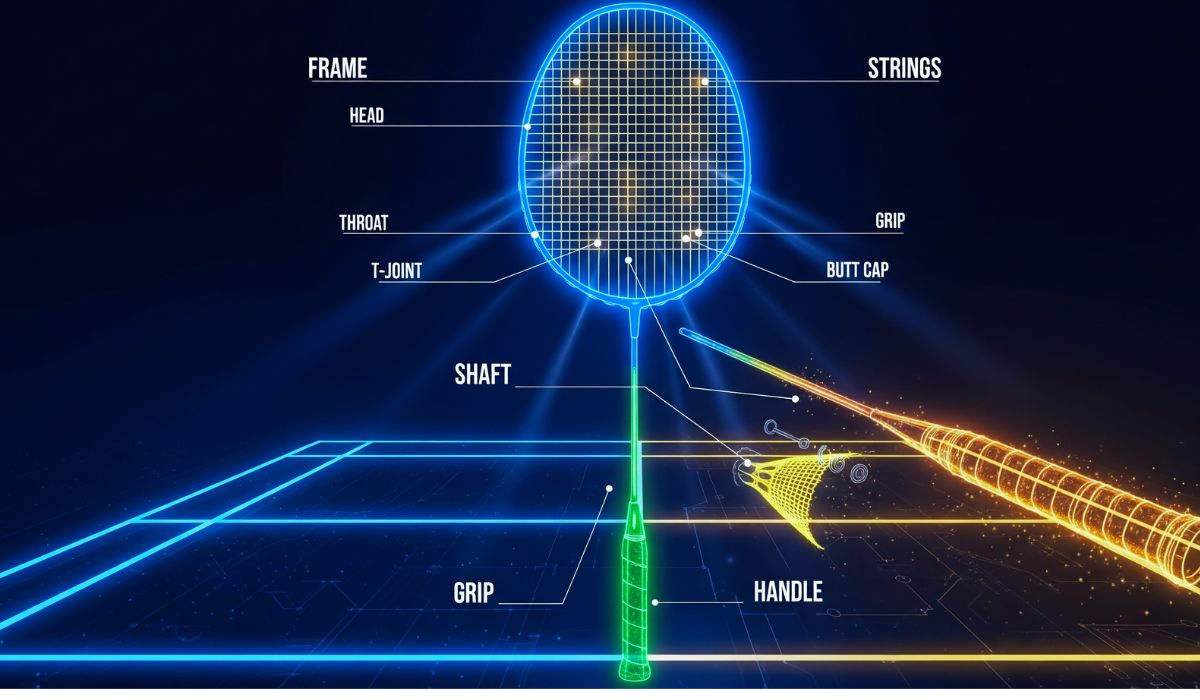The Shocking Truth Behind Every Part of a Badminton Racket – What Most Players Get Wrong These 7 Vital Parts Could Ruin Your Game
More Than Just a Racket
A badminton racket might look simple at first glance. But beneath its sleek frame lies a complex structure made of carefully engineered parts, each contributing to your control, power, and performance on the court. Whether you’re a beginner or someone obsessed with smashing birdies like a pro, knowing the detailed parts of a badminton racket can transform how you play. Most people overlook these subtle details—and that’s a costly mistake. Understanding the anatomy of your racket is not just smart—it’s essential.
In this guide, we’ll explore every vital part of a badminton racket in detail, why each part matters, and how small changes in these elements can mean the difference between victory and defeat.
The Frame: Your Weapon’s Foundation
The frame is the soul of the Badminton Rackets. It’s what gives the Badminton Rackets its shape and structure. Made from materials like carbon fiber or graphite, the frame determines the racket’s weight, stiffness, and balance. A lighter frame gives you speed, while a heavier frame delivers more power. This choice dramatically affects how your arm feels after extended matches and how well you handle high-speed rallies.
The Head: Where Precision Meets Power
The Badminton Rackets head is the rounded top portion that holds the string bed. This is the area that makes contact with the shuttlecock. The size and shape of the head affect the Badminton Rackets sweet spot—the magical zone where shots feel smooth, controlled, and powerful. Isometric heads offer a larger sweet spot, while oval heads deliver more focused accuracy. If you find yourself consistently missing your target, the shape of your Badminton Rackets head might be to blame.

The Shaft: Control in Every Swing
The shaft connects the handle to the head, and it plays a crucial role in flexibility and feel. A stiff shaft gives more control and faster recovery, which is ideal for experienced players. On the other hand, a flexible shaft generates more power with less effort—perfect for beginners or those who rely on clears and drop shots. The shaft’s length and stiffness affect how quickly you can react and how much finesse you can put into each shot.
The Grip or Handle: Where Comfort Begins
If you’ve ever played a long match and ended with a sore hand, it’s likely due to a poor grip. The handle is where your hand meets the Badminton Rackets, and grip size matters. A thicker grip allows for power shots but may limit wrist action. A thinner grip gives better control and quicker movements, ideal for net play and flicks. Wrapping the handle with a sweat-absorbent grip also prevents slips and boosts confidence.
The String Bed: The Heartbeat of Performance
Badminton Rackets Strings are not just a detail—they are the heart of the racket. Tension, material, and pattern all influence your game. High string tension (24–30 lbs) gives more control but demands precision. Low tension (18–23 lbs) gives more power and forgiveness. Nylon strings are durable for beginners, while multifilament strings offer better feel and responsiveness for competitive players. Strings also wear out faster than you expect, so regular restringing is key.
The Grommets: Small but Mighty
Grommets are the tiny plastic or rubber pieces inserted in the holes around the frame, through which Badminton Rackets strings are threaded. They protect the strings from direct contact with the hard frame, reducing wear and increasing the lifespan of your racket. Damaged or missing grommets can lead to snapped strings and costly replacements. They’re often ignored, but maintaining them makes a difference.
The T-Joint: The Core Connector
The T-joint is where the shaft meets the head. It can be external or internal, depending on the design of the Badminton Rackets. A strong, well-designed T-joint adds durability and stability to the racket. In many modern Badminton Rackets, the T-joint is built inside for a smoother frame and better aerodynamics. A weak joint can lead to wobble, poor control, and eventual Badminton Rackets damage.
Racket Balance Point: Light, Head-Heavy, or Even?
The balance point of a racket can either be head-heavy, head-light, or even-balanced. Head-heavy Badminton Rackets generate more smashing power and are preferred by attacking players. Head-light rackets are quicker and better for defensive play or fast net kills. Even-balanced Badminton Rackets are versatile, offering a mix of control and power. Knowing your balance preference helps you choose a Badminton Rackets that complements your playing style.
Weight Categories: Feel the Difference
Badminton rackets are categorized by weight, often using the “U” system (e.g., 3U, 4U, etc.). A 3U racket weighs around 85–89 grams, while a 4U is lighter (80–84g). Heavier rackets generate more force, but they’re harder to handle during quick exchanges. Lighter Badminton Rackets are great for speed and control. Your arm strength and game type will determine the ideal weight class for you.
Stiffness or Flexibility: A Game-Changer
The stiffness of your Badminton Rackets impacts how your energy transfers to the shuttle. A stiff Badminton Rackets offers crisp, accurate shots but requires strong wrist control. A flexible racket bends more during the swing, giving added power from the rebound. If you’re a player who loves deceptive shots or creative net play, flexibility can give you an advantage.
Material Composition: More Than Just Carbon
Most high-end Badminton Rackets today use graphite, carbon fiber, or even nanomaterials. These materials provide the perfect blend of strength, durability, and weight. Aluminum Badminton Rackets are cheaper but heavier and less responsive. The quality of materials affects vibration dampening, swing speed, and overall comfort.
Shaft Thickness: Hidden Influence
Though rarely noticed, the thickness of the shaft can affect aerodynamics and performance. A thinner shaft cuts through the air more quickly, giving faster swings, while a thicker shaft adds stiffness and stability. If your shots feel sluggish or your swing lacks snap, shaft thickness might be a hidden culprit.
Paint and Coating: Not Just for Looks
While paint and coatings may seem purely cosmetic, they serve to protect the frame from scratches, rust, and environmental wear. A high-quality matte or glossy finish can also impact the Badminton Rackets grip in sweaty conditions. Some coatings reduce wind resistance and enhance speed, giving you a slight but critical edge.
Customization Options: Make It Yours
Advanced players often tweak their Badminton Rackets—changing grips, adjusting weights, or swapping strings—to fine-tune performance. Understanding each part allows you to customize your racket based on specific needs. Want more control? Change to a thinner grip and tighter string tension. Looking for power? Try a heavier head and thicker shaft. Your racket should evolve with your skills.
Maintenance: A Racket’s Lifeline
Every Badminton Rackets, no matter how advanced, requires regular care. Replacing grips, checking grommets, and restringing every few months helps maintain optimal performance. Ignoring small issues like loose strings or cracked grommets can lead to long-term damage. Treat your Badminton Rackets like a partner—it needs attention to perform well.
Understanding the Soul of the Game: Why Every Part of the Racket Matters
At first glance, a badminton racket might seem like a simple tool. But once you dig deeper, you’ll realize it’s a piece of precision engineering. Every curve, angle, and tension point on the racket has a role to play. From the head to the shaft to the grip, each part is carefully crafted to influence power, speed, and control. For players who want to dominate on the court, understanding the anatomy of a badminton racket is not optional—it’s essential. A Badminton Rackets is not just a bat; it’s an extension of your arm, an interpreter of your game style, and sometimes the difference between a win and a heartbreaking loss.
The Racket Head: Your First Strike Zone
The head of a badminton racket is where the shuttlecock meets your intentions. It’s a powerful yet delicate structure that determines both your defensive returns and aggressive smashes. The stringed area—known as the string bed—is supported by the racket frame, which is usually oval or isometric. Oval heads are more compact, offering concentrated power, while isometric heads give a larger sweet spot for greater forgiveness. The material of the frame, usually graphite or carbon fiber, provides rigidity without compromising flexibility. That perfect smash that makes your opponent sweat? It begins right here.
Strings and Tension: The Pulse of the Racket
Just like guitar strings produce different sounds based on tension, the strings in a badminton racket produce different shot qualities based on their tightness. Higher tension offers more control and precision, making it perfect for advanced players who like to place the shuttle where they want. Lower tension, on the other hand, creates a trampoline effect, which adds power but may sacrifice accuracy. The material—usually synthetic gut or multifilament—also affects durability and responsiveness. Strings are not accessories—they are the pulse of your performance.
The Shaft: The Flexible Core That Dictates Your Game
Running between the handle and the head, the shaft acts like a hinge. Its flexibility defines how your Badminton Rackets reacts to your swing. A stiff shaft transfers energy quickly, perfect for strong, experienced players who want explosive shots. A flexible shaft absorbs more energy and releases it slowly, which is better suited for beginners or players who rely on deceptive shots. Manufacturers often add carbon nanotube or high modulus graphite to maintain strength without increasing weight. Choosing the wrong shaft could mean playing with lag or feeling disconnected from your racket.
The Throat: Stability in Every Motion
Not all Badminton Rackets have a visible throat, but when present, it’s the triangular section connecting the shaft to the head. It adds structural integrity and reduces frame distortion during high-speed smashes. For beginners, a racket with a throat might feel more stable and balanced, offering predictable performance during rallies. Advanced rackets often skip this to save weight and increase aerodynamics. This tiny detail often gets ignored, but it has a big role in stabilizing shots during pressure moments.
The Handle: Where Your Power Begins
Your connection to the racket starts with the handle. This is where grip and comfort translate into performance. A handle that’s too thick can strain your wrist; too thin, and you lose control. The base is typically wooden or synthetic, wrapped with grip material ranging from PU to towel grip. Some players add overgrips or change grip types seasonally depending on sweat absorption needs. A good grip enhances feel, control, and reduces slippage—especially during aggressive plays or long matches where fatigue can set in.
The Grip: More Than Just Comfort
A quality grip isn’t just about comfort; it affects your confidence. Players who switch grips mid-match know that feel plays a huge role in consistency. There are dry grips for sweat control and tacky grips for firm holds. Some grips reduce vibration, which can prevent injuries like tennis elbow. While it may seem like a secondary concern, your performance during crunch moments often depends on how secure and natural your grip feels. A good grip reduces hesitation, and that can make or break your final shot.
Racket Balance: Head-Heavy, Even, or Head-Light?
This subtle but powerful part of racket anatomy determines your game style. Head-heavy rackets provide momentum and smash power, preferred by attacking players. Head-light rackets are quicker to maneuver and perfect for defense or doubles. Even-balanced rackets offer a middle ground, ideal for all-rounders. It’s not just about how the racket feels in your hand—it’s how it behaves mid-swing. Misjudging balance could mean being consistently late to the shuttle or struggling to generate power on clears.
Racket Weight: A Misunderstood Factor
Many players think lighter is always better. But that’s not always true. Rackets are categorized from 1U (heavy) to 5U (ultra-light), and each category serves a purpose. Heavy rackets offer stability and power but can tire your wrist quickly. Lightweight rackets allow faster swings but may lack punch. Your playing style, strength, and stamina should dictate the weight you choose. Overlook this, and you might end up with the wrong partner in your match—a racket that slows you down or fails to deliver when needed.
The T-Joint: Hidden but Crucial
Modern rackets have either built-in or external T-joints. This joint ensures the head and shaft work together during impact. It stabilizes torsion and minimizes twisting, especially during off-center shots. For advanced rackets, the T-joint is reinforced with carbon materials for added strength without compromising weight. Though it’s mostly hidden from sight, it silently supports every swing, ensuring your racket doesn’t falter under stress.
Materials Used: The Science Behind the Swing
Materials in a badminton racket aren’t just about making it light—they define its durability, feel, and response. Common materials include carbon fiber, graphite, aluminum, and titanium. Some rackets even use nanotechnology for enhanced strength. The quality of material influences shock absorption, swing speed, and impact resistance. A poorly constructed racket might look sleek but could shatter under intense play. On the other hand, a high-quality material ensures your racket holds up through thousands of competitive smashes.
Grommets: The Tiny Guardians of Your Strings
Grommets are small but mighty. These little plastic rings lining the frame holes protect the strings from friction and tension damage. Without grommets, strings would break quickly due to rubbing against sharp edges. Advanced rackets have single or double grommet systems, each offering a different level of string freedom. Ignoring grommet wear is one of the fastest ways to shorten your racket’s life and reduce performance.

Sweet Spot: The Magic Zone
The sweet spot is the area on the string bed that delivers maximum power with minimum effort. It’s where your smash sounds crisp and feels like silk. Hitting the shuttle outside the sweet spot can lead to weak returns or arm strain. The shape and tension of the racket affect this zone. A large sweet spot is forgiving and ideal for newer players, while smaller, tighter spots reward precision. Finding and consistently hitting this magic zone is key to transforming your game.
Design and Aerodynamics: Silent Enhancers of Speed
Today’s rackets are wind-tested, aerodynamically refined tools. The frame design often includes air-flow grooves or streamlined shapes that reduce drag and increase speed. This matters in fast-paced rallies where milliseconds decide the winner. An aerodynamic frame lets you move the racket faster through the air, giving you quicker response time and better control. This is especially useful in doubles where reflex and speed reign supreme.
Racket Customization: Make It Truly Yours
One of the best parts of modern rackets is how customizable they are. From grip thickness to string pattern, tension level to added weights, players can tweak almost every component. This allows you to tailor the racket to your strengths, comfort, and playing strategy. You can even customize balance with lead tape or fine-tune control by adjusting shaft flexibility. Personalized equipment creates a sense of ownership and confidence—a psychological edge that can shift the balance in tight matches.
Final Thoughts: It’s Not Just a Racket—It’s Your Edge
Badminton is a sport of finesse, speed, and strategy. And your racket is the extension of your body and brain during every rally. Most players make the mistake of treating their racket as just a piece of equipment. But once you understand how each part works together—how it responds to your hand, your reflexes, and your instincts—you unlock a completely new level of gameplay.
The parts of a badminton racket are not just components; they are carefully designed tools crafted to support your unique style. Learn to read them, feel them, and use them, and you’ll elevate not just your shots—but your confidence and your entire approach to the game.

